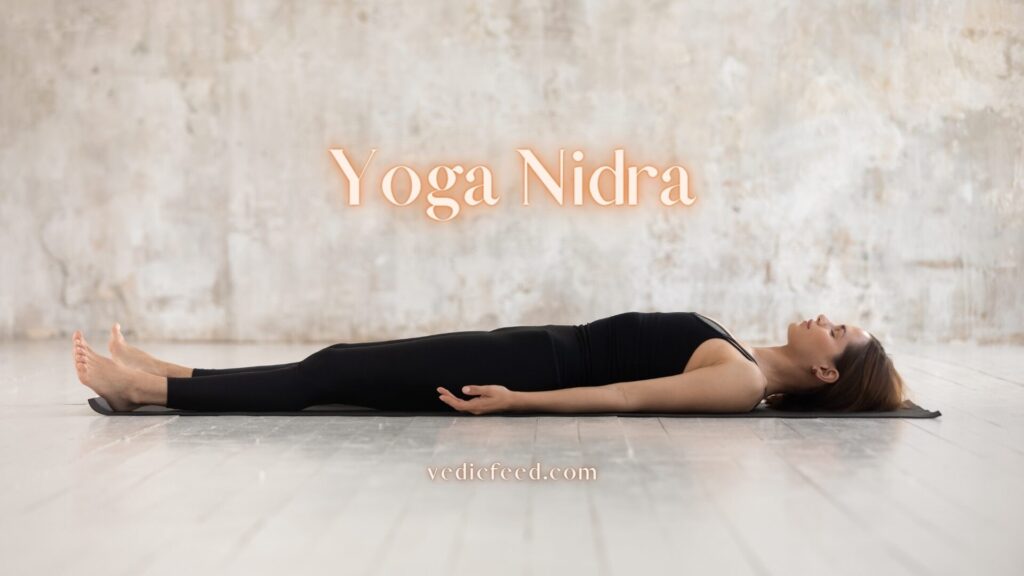Are you seeking a practice that helps you unwind after a long day or a tool to manage stress and anxiety? If so, Yoga Nidra may be the answer for you. Yoga Nidra, also known as Yogic Sleep, is an ancient practice that induces deep relaxation and profound meditation.

Modernized by Swami Satyananda Saraswati, a disciple of Swami Sivananda, Yoga Nidra is a complete relaxation technique that helps you tap into the body’s innate healing potential.
Contents show
What is Yoga Nidra?
Yoga Nidra is a state of conscious relaxation where you remain aware while your body is in a state of deep relaxation. The word Yoga Nidra comes from two Sanskrit words: Yoga, which means union or integration, and Nidra, which means sleep.
In a Yoga Nidra session, you are in a state between wakefulness and sleep, where the mind is fully alert, and the body is completely relaxed. In this state, you can access the deeper levels of the mind, including the subconscious, where true healing and transformation can occur.
Origin of Yoga Nidra

When awareness is separate and distinct from mental activity, when waking, dreaming and deep sleep pass like clouds, yet awareness of Self remains, this is the experience of total relaxation… That is why, in tantra, Yoga nidra is said to be the doorway to Samadhi.Swami Satyananda Saraswati
The origins of Yoga Nidra can be traced back to the ancient Indian text, the Upanishads. The Upanishads describe a state of consciousness called the Turiya, which is said to be the purest and most subtle level of consciousness.
In this state, the mind is free from all distractions and is able to access deeper levels of awareness. The practice of Yoga Nidra is believed to help individuals achieve this state of consciousness by allowing them to enter a deep state of relaxation where they are able to access their subconscious mind.
The modern form of Yoga Nidra was developed by Swami Satyananda Saraswati in the mid-20th century. Swami Satyananda Saraswati was a disciple of Swami Sivananda Saraswati and spent several years traveling throughout India, studying different forms of yoga and meditation. He eventually developed the practice of Yoga Nidra as a systematic method of inducing deep relaxation and accessing the subconscious mind.
Swami Satyananda Saraswati introduced Yoga Nidra to the West in the 1960s, and it quickly gained popularity as a powerful tool for stress reduction and self-exploration. Today, Yoga Nidra is widely practiced around the world and is recognized as a highly effective technique for promoting physical, mental, and emotional well-being.
Yoga Nidra on Mahabharata and Bhagavad Gita

In the epic Mahabharata and Bhagavad Gita, Lord Krishna is related to Yoga Nidra.
[The Ocean] becomes the bed of the lotus-navel Vishnu when at the termination of every Yuga that deity of immeasurable power enjoys Yoga-Nidra, the deep sleep under the spell of spiritual meditation. Mahabharata, Adi Parva, Section 21
अहमात्मा गुडाकेश सर्वभूताशयस्थित: |
अहमादिश्च मध्यं च भूतानामन्त एव च ||Bhagavad Gita, 10.20
Meaning: I am the Self, O Guḍākeśa, seated in the hearts of all creatures. I am the beginning, the middle, and the end of all beings. Lord Krishna referred to Arjuna as ‘Guḍākeśa,’ meaning one who has achieved such a state of mastery and is so highly evolved that he has overcome the need for sleep.
Is Yoga Nidra a form of Meditation?
Yes, Yoga Nidra is a form of meditation. It is a systematic relaxation technique that leads to a state of deep meditation while remaining in a state of consciousness between sleep and wakefulness. The practice of Yoga Nidra involves a guided meditation that takes the practitioner through different stages of relaxation and awareness, leading to a state of deep relaxation and meditation.
A Yoga Nidra Practice can access the subconscious mind and achieve a deep state of mental and physical relaxation, which can promote healing and well-being. So, in essence, Yoga Nidra is a form of meditation that can help the practitioner to achieve a deep state of relaxation and inner peace.
How to Practice Yoga Nidra?
Yoga Nidra can be practiced in various positions such as a comfortable seated position, lying down on your back, or in a supported position. A yoga mat or a blanket is recommended to keep your body warm and comfortable during the practice.
The practice of Yoga Nidra involves various stages, including relaxation, breath awareness, and rotation of consciousness. During the practice, you will be guided through a series of instructions to relax each part of your body systematically.
8 Steps of Yoga Nidra
Yoga Nidra is a deep relaxation and meditation practice that can help you achieve a state of deep sleep or rest and rejuvenation. Here is an explanation of the 8 steps to follow when practicing Yoga Nidra:
- Lie down comfortably on your back or sit in a comfortable position: The first step is to find a comfortable position, either lying down on your back with your arms at your sides, palms facing up, and legs slightly apart, or sitting in a comfortable cross-legged position with your spine straight. You want to make sure you are comfortable and that your body is well-supported. Use any props you need, such as a bolster or blanket, to make yourself comfortable.
- Close your eyes and take a few deep breaths: Close your eyes and take a few deep breaths, inhaling deeply through your nose, and exhaling fully through your mouth. Allow yourself to become aware of your breath and let go of any tension or stress you may be holding onto.
- Bring your awareness to the sensation of your breath: Bring your awareness to the sensation of your breath as it enters and leaves your body. You may notice the coolness of the air as you inhale and the warmth as you exhale. Focus your attention on your breath and let go of any thoughts or distractions that arise.
- Follow the guided instructions and relax each part of your body systematically: Follow the guided instructions for Yoga Nidra, which will lead you through a systematic relaxation of each part of your body. Starting at your toes and working your way up to your head, you will be guided to relax each part of your body, one at a time. You will be asked to focus your awareness on each body part and then release any tension or tightness that you may be holding in that area.
- Focus on the rotation of consciousness, where you move your awareness to different parts of your body: After relaxing each part of your body, you will be guided through the rotation of consciousness. This is where you move your awareness to different parts of your body, such as your right hand, left hand, right foot, left foot, and so on. You will be asked to focus your awareness on each body part for a few moments and then move on to the next one.
- Repeat a Sankalpa, which is a positive affirmation or a resolution that you make for yourself: After completing the rotation of consciousness, you will be asked to repeat a Sankalpa, which is a positive affirmation or a resolution that you make for yourself. This can be something that you want to achieve, a personal goal, or a positive affirmation that helps you feel more grounded and centered.
- Gradually bring your awareness back to your breath and then to your surroundings: After repeating your Sankalpa, you will be guided back to your breath, and then to your surroundings. You may be asked to take a few deep breaths and become aware of your body in space. Allow yourself to gradually become more alert and present.
- Take a few deep breaths and slowly open your eyes: Finally, take a few deep breaths and slowly open your eyes. Take a moment to notice how you feel and allow yourself to transition back to your regular activities slowly. This is the step to return back to your physical body.
By following these eight steps, you can experience deep relaxation and rejuvenation through the practice of Yoga Nidra.
Benefits of Yoga Nidra
The practice of this psychic sleep has many benefits for physical, mental, and emotional wellbeing. Here are some of the benefits of Yoga Nidra:
Deep Relaxation
Yoga Nidra induces a state of deep relaxation, which reduces tension and stress in the body. This relaxation response helps reduce the heart rate, blood pressure, and the levels of stress hormones in the body. Yoga Nidra also helps release muscular, emotional, and mental tensions, allowing you to experience profound relaxation.
Improved Sleep
The practice of Yoga Nidra helps improve the quality of sleep, making it an effective therapy for insomnia. Yoga Nidra practice improved sleep diary parameters such as sleep onset latency, sleep time, and total sleep time. Yoga Nidra practice significantly reduced daytime sleepiness in people with chronic insomnia.
Emotional Relaxation
Yoga Nidra helps release negative emotions and thought patterns, allowing you to experience emotional relaxation. It also helps improve emotional stability, resilience, and the ability to cope with stress and anxiety. The negative thought patterns from injection of emotions on normal consciousness can be healed from this dreamless sleep yoga.
Improved Concentration and Memory
A regular practice of Yoga Nidra leads to significant improvements in life satisfaction and reduced symptoms of anxiety and depression. Additionally, Yoga Nidra is effective in reducing symptoms of post-traumatic stress disorder (PTSD) in individuals who had experienced trauma.
Enhance Creativity
By accessing deeper levels of the mental awareness, the practice can unlock new ideas, insights, and perspectives. As the mind becomes more relaxed and open, individuals may find that they are better able to tap into their creative potential, whether in the form of artistic expression, problem-solving, or innovation. Furthermore, the practice can help individuals develop a more profound sense of intuition and inner wisdom, leading to enhanced creativity and personal growth.
Increase Self Awareness
The practice allows individuals to become more aware of their thoughts, emotions, and physical sensations. Through the process of deep relaxation and guided visualization, individuals are encouraged to explore their inner world, gaining insight into their deeper desires, motivations, and beliefs. This increased self-awareness can lead to improved emotional intelligence, better decision-making skills, and a more profound sense of purpose and meaning in life.
Reduce Anxiety and Stress
In today’s fast-paced world, stress and anxiety are common issues faced by many people. Yoga Nidra can be a useful tool to help manage stress and anxiety. The deep relaxation and meditative state induced by Yoga Nidra help to reduce the levels of the stress hormone cortisol in the body, promoting feelings of calmness and tranquility. The practice can also help individuals to develop coping mechanisms for stress, reducing the likelihood of being overwhelmed or anxious.
Research and Studies on Yoga Nidra
| Research | Conclusion |
|---|---|
| Effectiveness of a short Yoga Nidra meditation on stress, sleep, and well-being | Positively influence stress, sleep, and well-being |
| The Origin and Clinical Relevance of Yoga Nidra | Positive physiological changesImprovements in hematological variablesBalanced Red blood cell counts, blood glucose levels, and hormonal status |
| Yoga Nidra for treatment of anxiety and depressive symptoms in patients with menstrual abnormalities | Improvement of psychological problems emerged out of long standing menstrual irregularities |
| Using Yoga Nidra to Improve Stress in Psychiatric Nurses | Stress reduction, muscle tension, and self-care in nurses |
| Yoga Nidra practice in patients with chronic insomnia | Treatment of chronic insomnia after supervised practice sessions |
If you’re interested in experiencing the benefits of Yoga Nidra for yourself, consider attending a class at a local yoga studio or finding a certified Yoga Teacher. With regular practice, you may find that Yoga Nidra becomes an essential part of your daily life, helping you to live a more relaxed, fulfilling, and peaceful existence.




